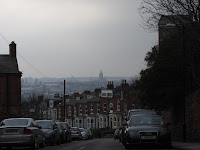A slightly better
week, although still feeling very much under the weather.
Work in Progress presentation
Friday’s session
in college was a series of work in progress presentations. I found the whole
day dragged and it over-ran to the point where I was practically asleep (not
least due to recovering from this bug), which wasn’t very polite to fellow
students. We seem to have had a spate of crits, work in progress, etc, and sometimes
you just have to do the work. Anyway…
I talked about the application of the “heritage” critical perspective, the laser
cut images of my face, the solar printing, drypoint etching, the generative
wandering and the acrylic pieces on paper. I got mixed feedback. One fellow
student felt I needed more structure in my work, like restricting it to one
theme e.g. the gasometers of Leeds, or one type of practice, e.g. printmaking.
Another fellow student felt the breadth of techniques added interest to the
themes. I guess there is always a tension between “freedom” and “system”. It’s true
I’ve sometimes felt a bit off down a blind alley this term but I have
repeatedly tried to take stock and pull myself back to a narrative that I can
explain. Perhaps I need to think about that and learn to explain it better!
I talked a bit
about decay arising from the charred MDF laser cut and another fellow student
suggested this could be a theme moving into the “decay of my heritage”. I guess
that theme is already there, but not overtly, so that is to think about for the
next module. When I talked about the generative wandering I mentioned the
people doing their thing in the present as I looked for the past (jogging,
baby-walking, Diamond White drinking) and that was reflected back to me in the
idea of temporality – another them to explore! From the tutor and fellow
students I got some names to look into: Karel Martins (designer), Daniel Eatock
(creates responses to something particular), Leeds Surrealist Group,
Psychogeography hub on Tate website, Paul Ricoeur, Zygmunt Baumann. So a few to
read up on over Easter.
Reading
Speaking of
reading: I had a skim over the first couple of chapters of “The Craftsman” by
Richard Sennett (2009), which had been recommended by my tutor. It didn’t grab
me – clearly not every book will do that. I felt his premise of Pandora’s
casket (sic) being equivalent to a culture of man-made things risking continual
self-harm (p2) needed more exploration and explanation to convince me. But
perhaps that’s because I’m an old programmer, not a Greek scholar. In fact
Sennett talks about programmers and business process improvement in chapter 1.
I’ve lived through what I need to know about both programming and process
improvement. So I’ve paused reading that book.
Much more relevant
to what I’m currently doing, but less snappily titled, is “Exploring Learning,
Identity & Power through Life History & Narrative Research”. Again,
I’ve only had time to skim the first one and a half chapters, but lots of
interesting ideas. Within the first few pages we have the idea of “life histories”
– one’s life story in the context of the social and historical conditions
prevailing (p2), problems around construction of identities which matter
because identities shape people’s practices (p3), and the idea of the tension
between the politics of the state and the possibility for social change through
the small everyday acts of individuals (p5). In Chapter 2, the ethics of
narrative enquiry are explored, including the fact that the researcher will
always have a stake in the formation of the written identities of the
participants because she or he too is a human being. I have only got to about
page 16 and I think there is plenty in here for me to explore and reflect upon.
The idea of “life history” is appealing as I think it relates to my idea of
“lived experience”; the individual’s experience at that particular point in the
space-time continuum. Also, even using myself and my own life history as a
source, I am reconstructing my own identity and experience – more clearly? Less
clearly? Tilting it to whatever I want to say now? I am hoping I can get time
to have a closer read of this book as it seems to complement some of the ideas
in Harrison’s book in terms of my own critical perspectives. I think this will
also have to be over Easter, the way things are going.
Making
In and amongst all
the reading and presenting, I have managed to etch a new plate based on my
generative wandering to Armley. I have only done two test prints so I will need
to work on it further next week. However, it is taking shape and looking
promising.
After the work in
progress presentations, I nipped onto the laser cutter and engraved the image of
my face into two pieces of corrugated cardboard. I wanted to work on these with
mixed media, again based on my Armley wandering. I’ve done a couple of coats of
acrylic with a 1-inch house brush. I’m just working freely and intuively with
these. They are test/experimental pieces but on a bigger scale than I’d
normally do such work – they are about 52 x 39cm each. The colours are based on
the colours I saw during the wandering, with the blue layer also possibly
representing the sky.
 |
| Armley 1 : Corrugated Cardboard Work in Progress |













